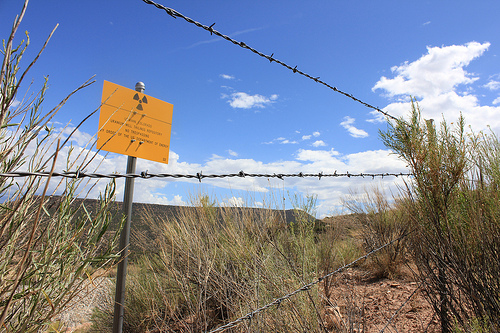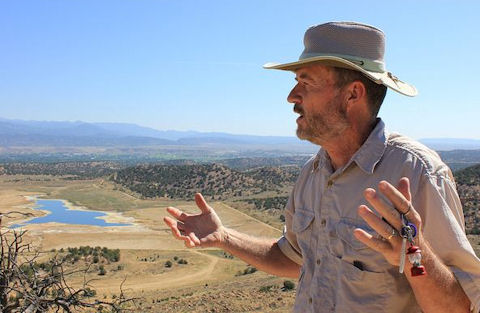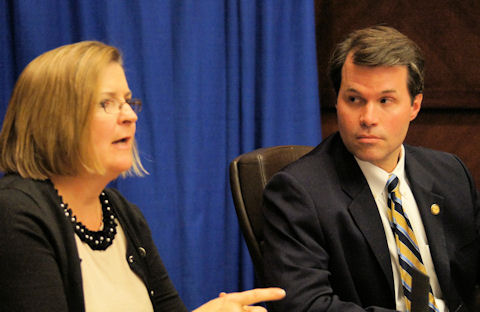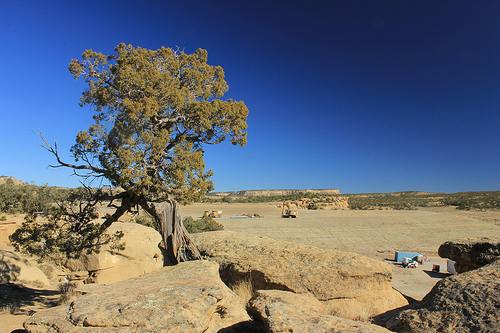
A juniper tree on Navajo land in New Mexico overlooks a pile of waste rock from an abandoned uranium mine subject to an ongoing clean-up effort.
Is it possible to restore a landscape damaged by uranium? Ask the Navajo in New Mexico.
by Rose Jenkins
This fall, near Teddy Nez’s house on the Navajo reservation near Gallup, N.M., men in earth-moving equipment were scraping away the topsoil, up to three feet deep, which had been contaminated by radioactivity from abandoned uranium mines. In earlier phases of this project, starting in 2007, crews had torn out 100-year-old junipers and piñon pines and had clawed earth away from the remaining trees, which weakened them, even after replacement soil was trucked in. The machines had flayed hillsides, whose cover of flowering shrubs and fragrant herbs has yet to grow back. “It looks like a B-52 hit it,” Nez told me, recalling an image from his service in Vietnam.
On our way to his house, Nez pointed out a notch in a bank of yellow grassland at the head of an arroyo. That’s where the Church Rock uranium mill tailings dam broke in 1979, releasing over 1,000 tons of radioactive wastes and millions of gallons of highly acidic water into the Puerco River, an intermittent stream that flows toward the Colorado River. The Church Rock dam failure was the largest radioactive release in U.S. history, by volume — larger than the Three Mile Island disaster the same year.
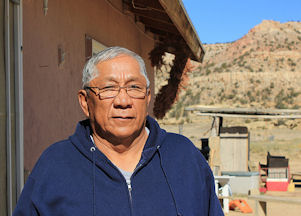
Teddy Nez, shown here at his house, believes that decades of exposure to contamination from two nearby uranium mines made him and his family sick.
Nez’s house was upstream of the breached dam but the ground around it was contaminated by dust drifting off of the mountainous piles of waste rock from two nearby uranium mines, which have been out of production for almost 30 years. Nez believes that the continuous exposure has made him and his family sick. His whole family suffers from respiratory problems, he says — himself, his five children, and his seven grandchildren.
For years, he and his neighbors fought for a clean-up, he says, but nothing happened. Finally, in 2007, the U.S. Environmental Protection Agency (EPA) informed them that their situation was an emergency. Radiation levels at Nez’s home measured up to ten times higher than normal background levels for the area.
Nez recounts, “The U.S. EPA says due to the human risk factor, get the people out. And they tell us, we’re going to move you out permanently, relocate you permanently. We say no. And the reason we’re saying no is… our culture, tradition. Our grandma and grandpa, they were here. So we don’t want to leave that land.”
The Navajo had been forced off of this land once before, when they were marched into exile by Kit Carson’s troops in 1864. Four years later, the tribe regained a portion of its homeland. Although many people had died, and their homes, livestock, fields, and orchards were destroyed, the Navajo returned to start over in the land between their four sacred mountains. Now, Nez and his community were unwilling to abandon their land. Clean it up, they demanded.
But what I saw in Navajo country made me wonder how much you can really clean up after uranium, if contaminants get into the soil, the water, the air, the plants, the animals.
I was particularly interested because of the debate over allowing uranium mining and milling (processing) in Virginia, my home state. Obviously, the circumstances are very different. Uranium was dug out of Navajo lands starting in the 1940s, in the rush to build the first atomic weapons and then to build up a Cold War arsenal. Virtually no effort was made to protect workers, the environment, or the community — although radiation was known to be dangerous. The tragedies endured by the Navajo resulted from uranium operations using crude, out-of-date methods, with little regard for human life or health. Times have changed.
Still, it’s worth noting what uranium can do to a landscape, what we can fix, and what we can’t. Read more.

